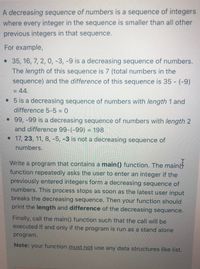
Database System Concepts
7th Edition
ISBN: 9780078022159
Author: Abraham Silberschatz Professor, Henry F. Korth, S. Sudarshan
Publisher: McGraw-Hill Education
expand_more
expand_more
format_list_bulleted
Question

Transcribed Image Text:A decreasing sequence of numbers is a sequence of integers
where every integer in the sequence is smaller than all other
previous integers in that sequence.
For example,
•35, 16, 7, 2, 0, -3, -9 is a decreasing sequence of numbers.
The length of this sequence is 7 (total numbers in the
sequence) and the difference of this sequence is 35 - (-9)
-44.
• 5 is a decreasing sequence of numbers with length 1 and
difference 5-5 = 0
•99,-99 is a decreasing sequence of numbers with length 2
and difference 99-(-99) = 198
•17, 23, 11, 8, -5, -3 is not a decreasing sequence of
%3D
numbers.
Write a program that contains a main() function. The main
function repeatedly asks the user to enter an integer if the
previously entered integers form a decreasing sequence of
numbers. This process stops as soon as the latest user input
breaks the decreasing sequence. Then your function should
print the length and difference of the decreasing sequence.
Finally, call the main() function such that the call will be
executed if and only if the program is run as a stand alone
program.
Note: your function must not use any data structures like list.
Expert Solution
This question has been solved!
Explore an expertly crafted, step-by-step solution for a thorough understanding of key concepts.
This is a popular solution
Trending nowThis is a popular solution!
Step by stepSolved in 3 steps with 1 images

Knowledge Booster
Learn more about
Need a deep-dive on the concept behind this application? Look no further. Learn more about this topic, computer-science and related others by exploring similar questions and additional content below.Similar questions
- = = 2×2 and 6 = (a) A composite number is a positive integer that has at least one divisor other than 1 and itself. For example, 2 1×2 is not a composite number but 4 2 × 3 are composite numbers. A logic circuit has four binary input variables, A, B, C and D. The output Z of the logic circuit is 1 if the unsigned integer represented by the binary number ABCD is a composite number. Using variables A and B for the select inputs S1 and S0 of a 4-to-1 multiplexer, implement the logic function Z(A, B, C, D) using this multiplexor and other logic gates.arrow_forwardA typical roulette wheel used in a casino has 38 slots that are numbered 1,2,3,....,36,0,00, respectively. Half of the remaining slots are red and half are black. Also, half of the integers between 1 and 36 inclusive are odd, half are even, and 0 and 00 are defined to be neither odd nor even. A ball is rolled around the wheel and ends up in one of the slots; we assume each slot has equal probability of 1/38, and we are interested in the number of the slot into which the ball falls. (a)Define the Sample space S. (b)Let A = {0,00}. Give the value of P(A). (c) Let B = {14,15,17 18}. Give the value of P(B). (d) Let D = {x:x is odd}. Give the value of P(D).arrow_forwardComputer sciencearrow_forward
- let n = 1*3*5*....*197*199 (the product of first 100 odd numbers) find the last 2 digits of narrow_forward3. Two 7-digit integers (leading zeros allowed) are considered to be equivalent if one can be obtained from the other by rearranging its digits. For example, 0012234, 0312042, 3220014 and 2100243 are all considered equivalent, whereas 0012234 and 0001234 are not equivalent. How many nonequivalent 7-digit integers are there in which the digits 0, 2, 4 and 6 can each appear at most once?arrow_forwardStart with a pile of n stones and successively split a pile into two smaller piles until each pile has only one Each time a split happens, multiply the number of stones in each of the two smaller piles. (For example, if a pile has 15 stones and you split it into a pile of 7 and another pile of 8 stones, multiply 7 and 8.) The goal of this problem is to show that no matter how the pile of n stones are split, the sum of the products computed at each split is equal to n(n - 1)/2. Using strong mathematical induction, prove that no matter how the pile of n stones are split, the sum of the products computed at each split is equal to n(n - 1)/2.arrow_forward
arrow_back_ios
arrow_forward_ios
Recommended textbooks for you
 Database System ConceptsComputer ScienceISBN:9780078022159Author:Abraham Silberschatz Professor, Henry F. Korth, S. SudarshanPublisher:McGraw-Hill Education
Database System ConceptsComputer ScienceISBN:9780078022159Author:Abraham Silberschatz Professor, Henry F. Korth, S. SudarshanPublisher:McGraw-Hill Education Starting Out with Python (4th Edition)Computer ScienceISBN:9780134444321Author:Tony GaddisPublisher:PEARSON
Starting Out with Python (4th Edition)Computer ScienceISBN:9780134444321Author:Tony GaddisPublisher:PEARSON Digital Fundamentals (11th Edition)Computer ScienceISBN:9780132737968Author:Thomas L. FloydPublisher:PEARSON
Digital Fundamentals (11th Edition)Computer ScienceISBN:9780132737968Author:Thomas L. FloydPublisher:PEARSON C How to Program (8th Edition)Computer ScienceISBN:9780133976892Author:Paul J. Deitel, Harvey DeitelPublisher:PEARSON
C How to Program (8th Edition)Computer ScienceISBN:9780133976892Author:Paul J. Deitel, Harvey DeitelPublisher:PEARSON Database Systems: Design, Implementation, & Manag...Computer ScienceISBN:9781337627900Author:Carlos Coronel, Steven MorrisPublisher:Cengage Learning
Database Systems: Design, Implementation, & Manag...Computer ScienceISBN:9781337627900Author:Carlos Coronel, Steven MorrisPublisher:Cengage Learning Programmable Logic ControllersComputer ScienceISBN:9780073373843Author:Frank D. PetruzellaPublisher:McGraw-Hill Education
Programmable Logic ControllersComputer ScienceISBN:9780073373843Author:Frank D. PetruzellaPublisher:McGraw-Hill Education

Database System Concepts
Computer Science
ISBN:9780078022159
Author:Abraham Silberschatz Professor, Henry F. Korth, S. Sudarshan
Publisher:McGraw-Hill Education

Starting Out with Python (4th Edition)
Computer Science
ISBN:9780134444321
Author:Tony Gaddis
Publisher:PEARSON

Digital Fundamentals (11th Edition)
Computer Science
ISBN:9780132737968
Author:Thomas L. Floyd
Publisher:PEARSON

C How to Program (8th Edition)
Computer Science
ISBN:9780133976892
Author:Paul J. Deitel, Harvey Deitel
Publisher:PEARSON

Database Systems: Design, Implementation, & Manag...
Computer Science
ISBN:9781337627900
Author:Carlos Coronel, Steven Morris
Publisher:Cengage Learning

Programmable Logic Controllers
Computer Science
ISBN:9780073373843
Author:Frank D. Petruzella
Publisher:McGraw-Hill Education